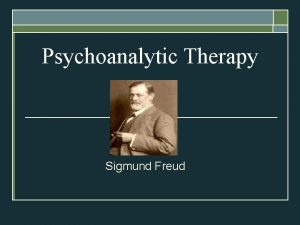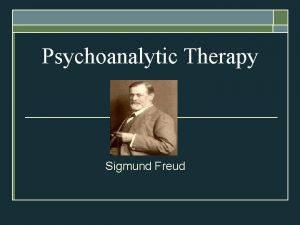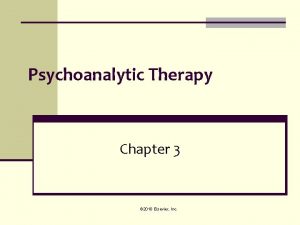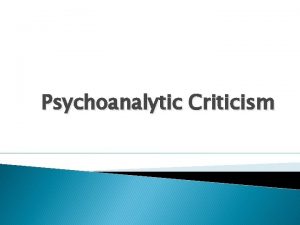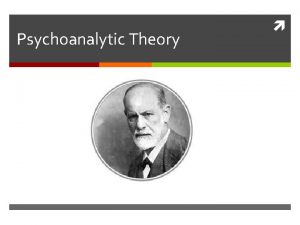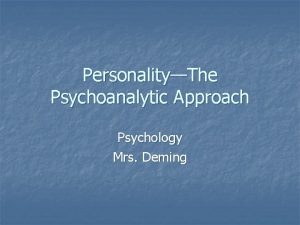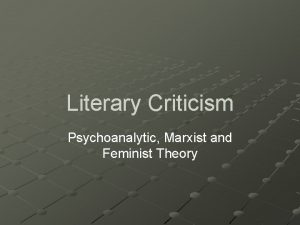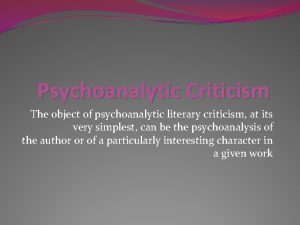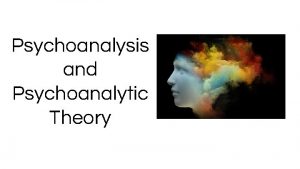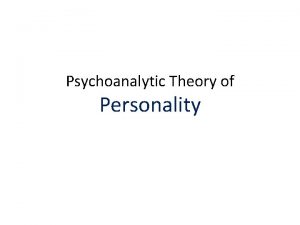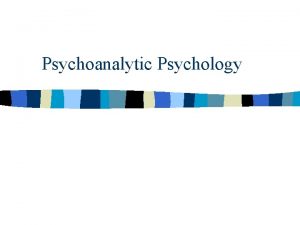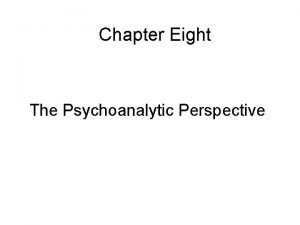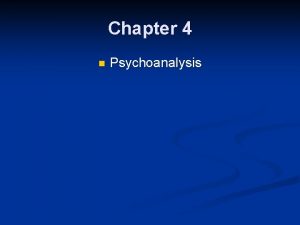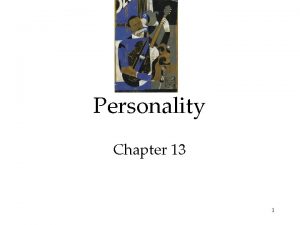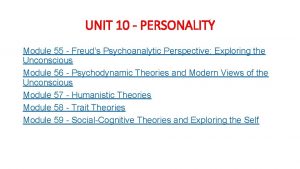The Psychoanalytic Perspective Chapter 13 Lecture 2 For

































![Homework Read p. 564 -567 “To criticize [Freud’s] theory by comparing it with current Homework Read p. 564 -567 “To criticize [Freud’s] theory by comparing it with current](https://slidetodoc.com/presentation_image_h/2eb0df47e7942e6d36ed6f0af3d79446/image-34.jpg)
- Slides: 34

The Psychoanalytic Perspective Chapter 13, Lecture 2 “For Freud the determinist, nothing was ever accidental. ” “In such ways, Freud suggested, the twig of personality is bent at an early age. ” - David Myers

Psychoanalytic Perspective Culver Pictures In his clinical practice, Freud encountered patients suffering from nervous disorders. Their complaints could not be explained in terms of purely physical causes. Sigmund Freud (1856 -1939)

Psychodynamic Perspective Culver Pictures Freud’s clinical experience led him to develop the first comprehensive theory of personality, which included the unconscious mind, psychosexual stages, and defense mechanisms. Sigmund Freud (1856 -1939)

Exploring the Unconscious A reservoir (unconscious mind) of mostly unacceptable thoughts, wishes, feelings, and memories. Freud asked patients to say whatever came to their minds (free association) in order to tap the unconscious.

Dream Analysis Another method to analyze the unconscious mind is through interpreting manifest and latent contents of dreams. The Nightmare, Henry Fuseli (1791)

Psychoanalysis The process of free association (chain of thoughts) leads to painful, embarrassing unconscious memories. Once these memories are retrieved and released (treatment: psychoanalysis) the patient feels better.

Model of Mind The mind is like an iceberg. It is mostly hidden, and below the surface lies the unconscious mind. The preconscious stores temporary memories.

Personality Structure Personality develops as a result of our efforts to resolve conflicts between our biological impulses (id) and social restraints (superego).

Id, Ego and Superego The id unconsciously strives to satisfy basic sexual and aggressive drives, operating on the pleasure principle, demanding immediate gratification. The ego functions as the “executive” and mediates the demands of the id and superego. The superego provides standards for judgment (the conscience) and for future aspirations. “Just as the body unconsciously defends itself against disease, so also, believed Freud, does the ego unconsciously defend itself against anxiety. ” - David Myers

Personality Development Freud believed that personality formed during the first few years of life divided into psychosexual stages. During these stages the id’s pleasure-seeking energies focus on pleasure sensitive body areas called erogenous zones.

Psychosexual Stages Freud divided the development of personality into five psychosexual stages. p. 556

Oedipus Complex A boy’s sexual desire for his mother and feelings of jealousy and hatred for the rival father. A girl’s desire for her father is called the Electra complex.

Charles Potkay and Ben Allen describe Freud’s case study of Little Hans as the cornerstone of Freud’s ideas about the Oedipus complex. Five-year-old Hans was afraid to leave his house because of an irrational fear that a horse would bite him. Hans developed the fear after having seen a horse fall down in the street. Freud believed that the real target of Hans’ fear was something else; through displacement Hans’s unconscious anxiety had merely been redirected from its original source onto horses. Freud suggested that Hans was actually afraid of his erotic feelings toward his mother and aggressive wishes toward his father. Potkay, C. R. , & Allen, B. P. (1986). Personality: Theory, research and application. Monterey, CA: Brooks/Cole.

Freud supported his hypothesis with the following observations: 1. Hans has said he wanted to sleep with his mother, “coax with” or caress her, be married to her, and have children “just like daddy. ” 2. Hans experienced castration anxiety. His parents warned that if he continued to play with his “widdler” (penis), it would be cut off. He noticed that his sister had no “widdler. ” 3. Hans wanted his mother all to himself, was jealous of his father, and feared his mother would prefer his father’s bigger widdler, which was “like a horse. ” Potkay, C. R. , & Allen, B. P. (1986). Personality: Theory, research and application. Monterey, CA: Brooks/Cole.

Freud supported his hypothesis with the following observations: 4. Hans was most afraid of horses with black muzzles, similar to his father’s black moustache. Hans had “accidentally” knocked a statue of a horse from its stand. When he saw a real horse fall down, he recognized his own aggressive impulse that his father fall down and die, an idea that frightened him and that he could not consciously acknowledge. Horses, then, were symbolic substitutes for Hans’s father, whom he both feared and hated. Potkay, C. R. , & Allen, B. P. (1986). Personality: Theory, research and application. Monterey, CA: Brooks/Cole.

Freud supported his hypothesis with the following observations: 5. Through psychoanalysis, the unconscious was made conscious. Hans’s fears were brought into the open and he achieved insight. Freud observed, “Hans was really a little Oedipus who wanted to have his father ‘out of the way, ’ to get rid of him, so that he might be alone with his handsome mother and sleep with her. ” Potkay, C. R. , & Allen, B. P. (1986). Personality: Theory, research and application. Monterey, CA: Brooks/Cole.

Identification From the K. Vandervelde private collection Children cope with threatening feelings by repressing them and by identifying with the rival parent. Through this process of identification, their superego gains strength that incorporates their parents’ values.

Defense Mechanisms The ego’s protective methods of reducing anxiety by unconsciously distorting reality. 1. Repression banishes anxiety-arousing thoughts, feelings, and memories from consciousness. 2. Regression leads an individual faced with anxiety to retreat to a more infantile psychosexual stage.

Defense Mechanisms 3. Reaction Formation causes the ego to unconsciously switch unacceptable impulses into their opposites. People may express feelings of purity when they may be suffering anxiety from unconscious feelings about sex. 4. Projection leads people to disguise their own threatening impulses by attributing them to others.

Defense Mechanisms 5. Rationalization offers self-justifying explanations in place of the real, more threatening, unconscious reasons for one’s actions. 6. Displacement shifts sexual or aggressive impulses toward a more acceptable or less threatening object or person, redirecting anger toward a safer outlet.

Defense Mechanisms 7. Denial protects the person from real events that are painful to accept, either by rejecting a fact or its seriousness Here is a chart summarizing the most important Freudian defense mechanisms.

The Neo-Freudians National Library of Medicine Like Freud, Adler believed in childhood tensions. However, these tensions were social in nature and not sexual. A child struggles with an inferiority complex during growth and strives for superiority and power. Alfred Adler (1870 -1937)

The Neo-Freudians The Bettmann Archive/ Corbis Like Adler, Horney believed in the social aspects of childhood growth and development. She countered Freud’s assumption that women have weak superegos and suffer from “penis envy. ” Karen Horney (1885 -1952)

The Neo-Freudians Archive of the History of American Psychology/ University of Akron Jung believed in the collective unconscious, which contained a common reservoir of images derived from our species’ past. This is why many cultures share certain myths and images such as the mother being a symbol of nurturance. Carl Jung (1875 -1961)

Assessing Unconscious Processes Evaluating personality from an unconscious mind’s perspective would require a psychological instrument (projective tests) that would reveal the hidden unconscious mind.

Thematic Apperception Test (TAT) Developed by Henry Murray, the TAT is a projective test in which people express their inner feelings and interests through the stories they make up about ambiguous scenes. Lew Merrim/ Photo Researcher, Inc.

Rorschach Inkblot Test The most widely used projective test uses a set of 10 inkblots and was designed by Hermann Rorschach. It seeks to identify people’s inner feelings by analyzing their interpretations of the blots. Lew Merrim/ Photo Researcher, Inc.

Projective Tests: Criticisms Critics argue that projective tests lack both reliability (consistency of results) and validity (predicting what it is supposed to). 1. When evaluating the same patient, even trained raters come up with different interpretations (reliability). 2. Projective tests may misdiagnose a normal individual as pathological (validity).

Evaluating the Psychoanalytic Perspective Modern Research 1. Personality develops throughout life and is not fixed in childhood. 2. Freud underemphasized peer influence on the individual, which may be as powerful as parental influence. 3. Gender identity may develop before 5 -6 years of age.

Evaluating the Psychoanalytic Perspective Modern Research 4. There may be other reasons for dreams besides wish fulfillment. 5. Verbal slips can be explained on the basis of cognitive processing of verbal choices. 6. Suppressed sexuality leads to psychological disorders. Sexual inhibition has decreased, but psychological disorders have not.

Evaluating the Psychoanalytic Perspective Freud's psychoanalytic theory rests on the repression of painful experiences into the unconscious mind. The majority of children, death camp survivors, and battle-scarred veterans are unable to repress painful experiences into their unconscious mind.

The Modern Unconscious Mind Modern research shows the existence of nonconscious information processing. This involves: 1. schemas that automatically control perceptions and interpretations 2. the right-hemisphere activity that enables the splitbrain patient’s left hand to carry out an instruction the patient cannot verbalize 3. parallel processing during vision and thinking 4. implicit memories 5. emotions that activate instantly without consciousness 6. self-concept and stereotypes that unconsciously influence us

Evaluating the Psychoanalytic Perspective The scientific merits of Freud’s theory have been criticized. Psychoanalysis is meagerly testable. Most of its concepts arise out of clinical practice, which are the after-the-fact explanation. “We arguing like a man who should say, ‘If there were an invisible cat in that chair, the chair would look empty; but the chair does look empty; therefore there is an invisible cat in it. ” - C. S. Lewis
![Homework Read p 564 567 To criticize Freuds theory by comparing it with current Homework Read p. 564 -567 “To criticize [Freud’s] theory by comparing it with current](https://slidetodoc.com/presentation_image_h/2eb0df47e7942e6d36ed6f0af3d79446/image-34.jpg)
Homework Read p. 564 -567 “To criticize [Freud’s] theory by comparing it with current concepts, some say, is like criticizing Henry Ford’s Model T by comparing it with today’s hybrid cars. ” - David Myers
 Freud fixation theory
Freud fixation theory Perspective of freud's psychoanalytic theory
Perspective of freud's psychoanalytic theory 01:640:244 lecture notes - lecture 15: plat, idah, farad
01:640:244 lecture notes - lecture 15: plat, idah, farad 1 point vs 2 point perspective
1 point vs 2 point perspective Silo perspective vs business process perspective
Silo perspective vs business process perspective Fspos vägledning för kontinuitetshantering
Fspos vägledning för kontinuitetshantering Novell typiska drag
Novell typiska drag Tack för att ni lyssnade bild
Tack för att ni lyssnade bild Returpilarna
Returpilarna Shingelfrisyren
Shingelfrisyren En lathund för arbete med kontinuitetshantering
En lathund för arbete med kontinuitetshantering Särskild löneskatt för pensionskostnader
Särskild löneskatt för pensionskostnader Tidböcker
Tidböcker A gastrica
A gastrica Densitet vatten
Densitet vatten Datorkunskap för nybörjare
Datorkunskap för nybörjare Stig kerman
Stig kerman Mall för debattartikel
Mall för debattartikel Autokratiskt ledarskap
Autokratiskt ledarskap Nyckelkompetenser för livslångt lärande
Nyckelkompetenser för livslångt lärande Påbyggnader för flakfordon
Påbyggnader för flakfordon Lufttryck formel
Lufttryck formel Offentlig förvaltning
Offentlig förvaltning Urban torhamn
Urban torhamn Presentera för publik crossboss
Presentera för publik crossboss Argument för teckenspråk som minoritetsspråk
Argument för teckenspråk som minoritetsspråk Plats för toran ark
Plats för toran ark Klassificeringsstruktur för kommunala verksamheter
Klassificeringsstruktur för kommunala verksamheter Fimbrietratt
Fimbrietratt Bästa kameran för astrofoto
Bästa kameran för astrofoto Centrum för kunskap och säkerhet
Centrum för kunskap och säkerhet Verifikationsplan
Verifikationsplan Mat för unga idrottare
Mat för unga idrottare Verktyg för automatisering av utbetalningar
Verktyg för automatisering av utbetalningar Rutin för avvikelsehantering
Rutin för avvikelsehantering



































